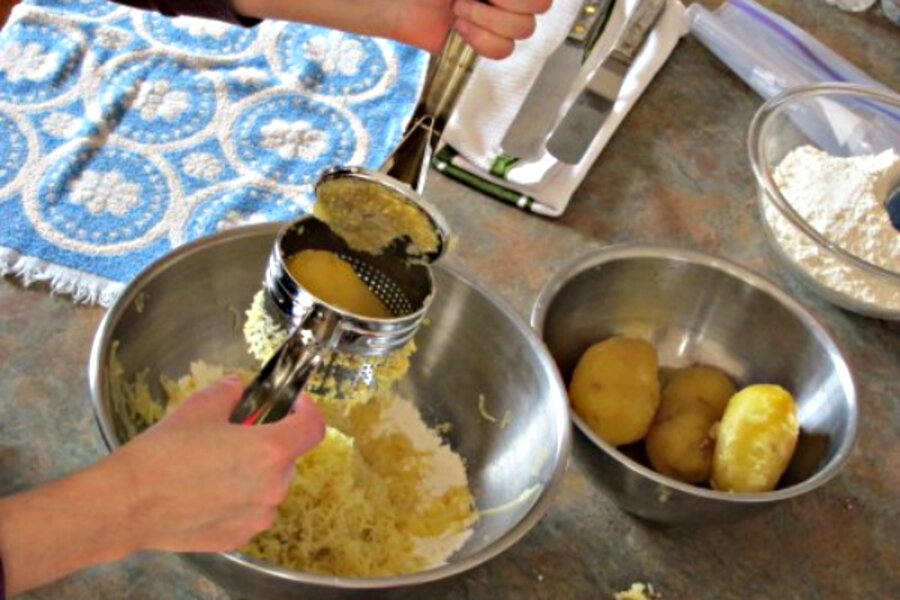Homemade gnocchi
Loading...
One of my food goals for 2012 was to try my hand at making gnocchi from scratch. I love these little potato dumplings, whether served with a simple marinara sauce, sage and browned butter, or lamb ragu. I bought a gnocchi board just to encourage myself, but it languished in the pantry for a few months awaiting the right opportunity. Last weekend, that opportunity came.
I spent a recent weekend with my friend Christie in Eastern Washington, and Saturday was gnocchi making day. We went over to the home of her friends Pete and Jewel late in the morning. Jewel is a cook of extraordinary calibre, and was gracious enough to teach us how to make Pete’s mother’s gnocchi, also known as Cavatele, or “sinkers” – a reference to the lead sinkers put on fishing lines. Gnocchi can have that effect, filling the tummy surprisingly quickly.
Jewel had done some advance work in the kitchen. A crockpot of sauce burbled on the counter. A cauldron of potatoes boiled on the stovetop. And the large center island was already stacked with eggs, flour, bowls, and utensils.
When the potatoes were done, we peeled them while they were still hot, then shot them through a ricer into a bowl of flour. We sifted and stirred this mixture with our hands until the potatoes were incorporated into the flour and cooled enough to not cook the eggs. Jewel warned us not to mash the potatoes into the flour, so we tried to use a light touch.
She dumped this mixture onto the counter, created a well in the center, and cracked eggs into it. After salting the eggs she stepped back and let us mix the eggs into the flour with our hands, smashing and kneading until we had a ragged but cohesive pile.
Then it was our turn to step back while Jewel kneaded the dough until she judged it smooth enough, but not too stiff. The dough rested under a bowl for half an hour, while we rested on stools around the counter and engaged in the sort of relaxed conversation that happens best in a warm kitchen during the pauses in a cooking project. Kitchen wisdom was shared. Ideas were batted back and forth.
Soon the dough was ready and we began by rolling it into snakes, then cutting these snakes into inch-long nuggets. I felt my brow furrowing and my tongue poking out between my teeth as I tried to follow Jewel’s swift movements. She took a piece of dough and, pressing two fingers into the middle, gave it a sort of roll and a flick on the counter top, set aside a gnocchi with the characteristic dimple in the middle, then made another and another. My hands struggled to copy her practiced motions, but after a few tries, using the gnocchi board for assistance, I had it – more or less – and began to produce a series of irregular dumplings.
Jewel started boiling the gnocchi while Christie and I made more. When she decided that they were perfect – plump and firm but no longer chewy – she drained the gnocchi and mixed them with sauce. We all got a little sample bowl of gnocchi and one of her meatballs to enjoy. Our gnocchi were good, but I nearly burst into applause after my first bite of meatball. Truly, it was worthy of a standing ovation. But this was only a teaser to whet our appetites for later.
We returned that evening for dinner, to gather around a long table set with a big pan of saucy gnocchi, meatballs the size of my fist, Italian sausage, garlic bread, grated cheese, and an extra pitcher of sauce. We laughed, and talked, and ate. I felt proud of our efforts, as I slowly savored the pillowy gnocchi. Everything on the table was incredibly delicious, but more than that; it was made and served with love.
“Do you ever write about how food is more than just food?” Pete asked as he gazed down the loaded table in my direction.
May I never write about anything else.
Jewel’s Cavatelli (Gnocchi) Recipe
3 to 5 medium red potatoes
3 to 5 cups flour
3 to 5 eggs
1 tablespoon cooking oil
1 teaspoon salt
Start with cold water. Boil 3 to 5 medium red potatoes with skins in unsalted water for 25 – 30 minutes. Peel potatoes while still hot.
Place 3 to 5 cups of flour in kneading bowl. Rice the skinned potatoes into flour bowl and slowly add flour. Sift potatoes and flour through fingers until cool; do not mash together.
Add 3 to 5 unbeaten eggs to well made in mixture after cool. Salt eggs. Knead until smooth.
Cover 1/2 hour. Roll out into a snake 1/2-inch thick. Cut 1 inch long pieces. Press with two lightly floured fingers in center and roll open like large macaroni to form cavatelli, little hot dog bun-shaped dough rolls
Let dry 10 minutes.
Add 1 tablespoon oil and 1 teaspoon salt to boiling water. Drop the cavatelli in large pot of rapidly boiling water, boil for approximately 30 minutes. Add a handful at a time so the water keeps boiling. If you let the water cool down they get gummy. Be sure to use lots of water when you cook and stir gently but often.
Drain and mix with spaghetti sauce and serve or keep warm in oven until ready.
Serve with spaghetti sauce and meatballs.






